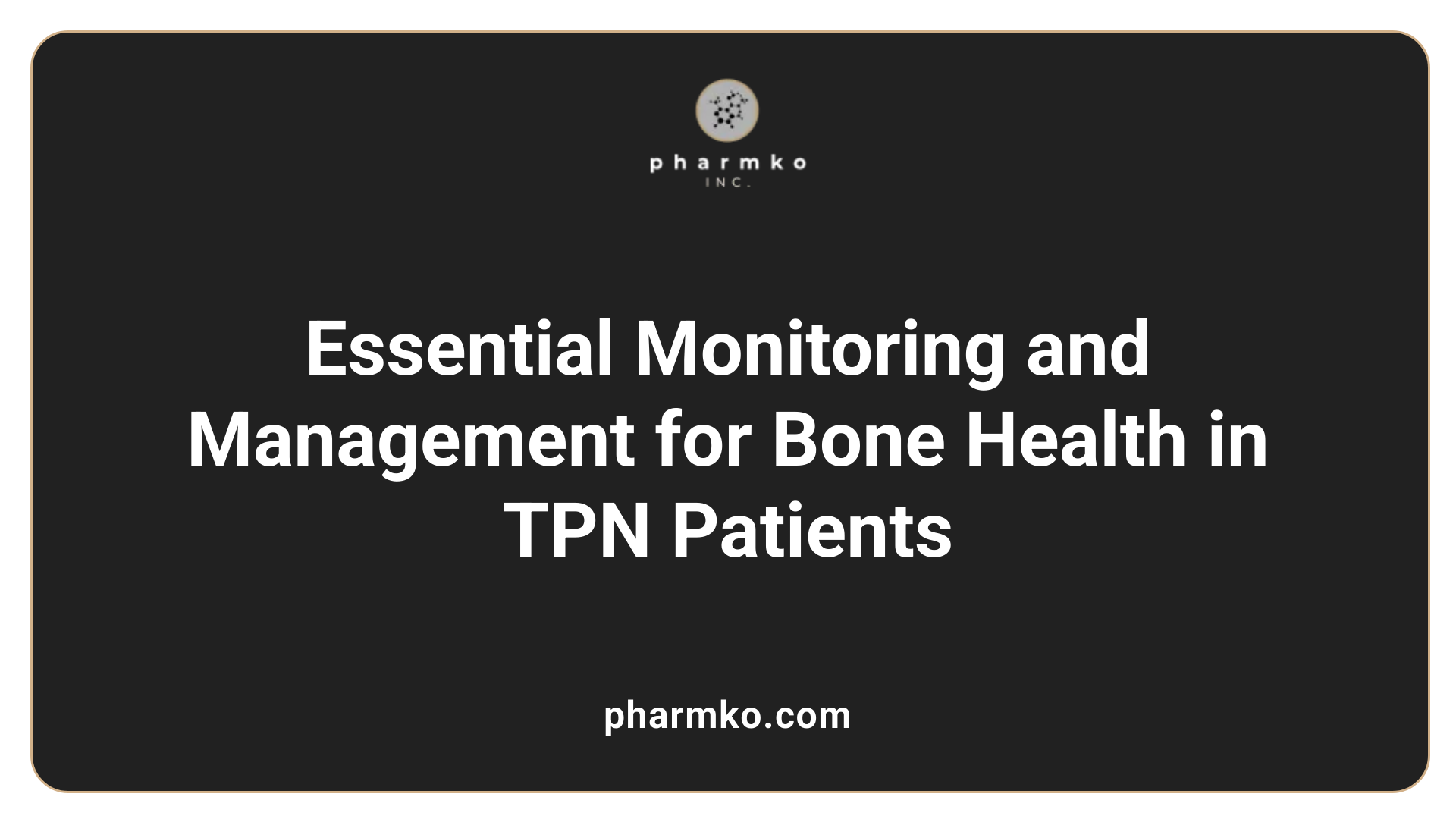The Link Between TPN and Bone Health: A Look at Calcium and Vitamin D
Exploring the Connection Between Parenteral Nutrition and Skeletal Integrity
Total parenteral nutrition (TPN) is a lifesaving intervention for patients who cannot obtain adequate nutrients via the gastrointestinal tract. However, long-term TPN has been associated with metabolic bone disease (MBD), consisting of conditions like osteoporosis and osteomalacia, which compromise bone strength and increase fracture risk. This article delves into the complex relationship between TPN, calcium, and vitamin D, examining how these nutrients influence bone health, the risks associated with their imbalance, and strategies to optimize nutritional management to prevent bone deterioration.
The Pathogenesis of Bone Disorders in TPN Patients
Can TPN cause osteoporosis?
Long-term total parenteral nutrition (TPN) can contribute to bone health issues, primarily through nutritional deficiencies. Insufficient intake or absorption of essential minerals such as calcium and phosphorus, along with inadequate vitamin D levels, play significant roles in the development of metabolic bone disease (MBD). This disease encompasses conditions like osteoporosis, which involves decreased bone mass and increased fracture risk. Multiple studies have documented that patients on prolonged TPN are at risk for developing osteomalacia, characterized by impaired mineralization of bone tissue.
Although TPN provides vital nutritional support, it can sometimes lead to negative effects on bone health if not carefully formulated. Factors such as calcium-phosphate imbalance, vitamin D deficiency, and impaired mineral metabolism are pivotal. In particular, disturbances in calcium homeostasis—due to either insufficient intake or issues with absorption—can accelerate bone demineralization.
Historical factors like aluminum contamination in early PN solutions
The early days of parenteral nutrition saw significant challenges related to aluminum contamination in PN solutions. During the 1980s, cases of osteomalacia and impaired bone mineralization were linked to high aluminum levels present in some PN formulations. Aluminum, when accumulated in bones, interfered with calcium phosphate mineralization, leading to osteomalacia and other skeletal abnormalities.
Such contamination was largely due to the use of aluminum-containing components in PN solutions, including certain amino acids and water sources. The toxicity of aluminum, particularly in patients with renal impairment or immature renal function, exacerbated problems with bone mineralization.
Modern PN solutions and their improved safety profile
Advances in manufacturing and formulation have significantly improved the safety profile of PN solutions. Today, most PN formulations are free of high aluminum content, reducing the risk of aluminum-related bone disease. Efforts to eliminate or minimize aluminum exposure in PN have been successful, which has decreased the incidence of aluminum-associated osteomalacia.
Current PN solutions are carefully designed to include optimal amounts of calcium, phosphorus, and vitamin D, in line with the nutritional needs of patients. Moreover, modern PN protocols emphasize the importance of balancing minerals to prevent precipitation issues and ensure proper bone mineralization.
Table 1: Historical vs. Modern PN Formulations and Safety Aspects | Aspect | Historical PN | Modern PN | Details | | Offending Element | High aluminum contamination | Minimal aluminum | Aluminum was used in amino acids and water sources, now minimized | | Supplementation | Often inadequate calcium and vitamin D | Tailored mineral and vitamin D supplementation | To meet individual patient needs | | Bone Disease Incidence | Higher rates of osteomalacia | Significantly reduced | Correlated with contamination and imbalanced mineral content | | Monitoring | Less routine | Regular assessment of calcium, phosphate, vitamin D, and bone density | Ensuring therapy adjustments |
Development of metabolic bone disease in long-term TPN patients
Patients on TPN for extended periods often develop MBD, including osteoporosis and osteomalacia. This syndrome may be insidious, with patients experiencing symptoms such as bone pain, fragility fractures, and skeletal deformities.
Research data show that in some cases, these patients have normal serum calcium, phosphorus, and vitamin D levels, yet still exhibit defective bone mineralization. Bone biopsies reveal patchy osteomalacia, impaired mineralization, decreased bone turnover, and hypercalciuria. Notably, these complications can occur even with adequate serum levels, indicating complex underlying mechanisms.
A case study involving adults on TPN for over three months highlighted these issues. Despite normal serum parameters, patients displayed severe bone pain and radiographic evidence of bone demineralization. Importance is placed on regular evaluation of bone mineral density and mineral metabolism markers.
Current strategies to prevent and manage bone disorders in TPN
Proper formulation of PN solutions is crucial. This includes adjusting calcium and phosphorus doses to promote a positive mineral balance, typically infusing around 15 mEq of calcium daily.
Close monitoring of mineral and vitamin D status is recommended. Laboratory assessments include serum calcium, phosphate, magnesium, 25-hydroxyvitamin D, and parathyroid hormone levels.
Preventive measures involve encouraging physical activity, addressing underlying metabolic conditions, and modifying PN formulas as needed. Pharmacologic treatments such as bisphosphonates or bone anabolic agents are gaining interest.
In summary, while advancements have reduced the occurrence of TPN-related bone disease, ongoing vigilance is necessary. Optimal mineral supplementation, regular monitoring, and individualized therapy remain the cornerstones of preventing MBD in long-term TPN patients.
Nutritional Components Critical for Bone Integrity in TPN

Can TPN cause osteoporosis?
Long-term total parenteral nutrition (TPN) can negatively influence bone health, leading to conditions like metabolic bone disease (MBD), which encompasses osteoporosis and osteomalacia. Multiple factors contribute to this decline, including nutritional deficiencies in calcium, phosphorus, and vitamin D. Insufficient intake or malabsorption of these nutrients disrupts normal bone mineralization, resulting in decreased bone density and increased fracture risk. These deficiencies may originate from the composition of TPN solutions, which historically contained high aluminum levels that affected bone mineralization but have since been reduced. Ensuring adequate mineral provision and monitoring are vital strategies in preventing osteoporosis in TPN patients.
What is the major concern with the combination of calcium and phosphate in TPN?
One of the key challenges in formulating TPN solutions is managing mineral balance, especially the combination of calcium and phosphate. When calcium and phosphate concentrations are too high or not properly balanced, there is a significant risk of calcium phosphate precipitation. This can lead to clogs in intravenous lines and cause embolic complications, posing a serious safety concern. It is essential to optimize dosing strategies so that both minerals remain soluble and bioavailable without forming insoluble precipitates.
What is the link between vitamin D, calcium, and bone health?
Vitamin D is integral to maintaining healthy bones by facilitating calcium and phosphorus absorption in the intestines. Adequate vitamin D levels enable the body to utilize these minerals effectively for bone mineralization, providing bones with the necessary strength and density. Inadequate vitamin D—caused by limited sun exposure, poor dietary intake, or malabsorption—can result in softening of bones, evident as rickets in children and osteomalacia in adults. Chronic deficiency increases the risk of osteoporosis and fractures later in life.
Sources of vitamin D include sunlight, fatty fish such as salmon and mackerel, fortified foods, and supplements. Since sunlight exposure varies seasonally and geographically, targeted vitamin D supplementation is essential, especially in regions like the UK where limited sun is common during winter months.
How does vitamin D influence calcium homeostasis and bone health?
Vitamin D enhances calcium absorption from the gastrointestinal tract, which is crucial for maintaining proper calcium levels in the blood and ensuring sufficient mineralization of bones. It also suppresses parathyroid hormone (PTH) secretion, which otherwise stimulates bone resorption to restore serum calcium. A deficiency in vitamin D disrupts this balance, leading to decreased calcium availability for bones, weaker bone matrix, increased osteomalacia, and higher susceptibility to fractures.
Table of Essential Minerals and Their Role in Bone Health
| Mineral | Function | Typical Dosing Strategy in TPN | Additional Notes |
|---|---|---|---|
| Calcium | Primary mineral for bone strength | About 15 mEq daily; calcium chloride or gluconate | Balance with phosphate to prevent precipitation |
| Phosphorus | Critical for bone mineral matrix | Customized to meet needs, monitored regularly | Excess can lead to soft tissue calcification |
| Magnesium | Supports bone structure and enzyme function | Adjusted based on serum levels and needs | Deficiency linked to osteoporosis |
Optimal Dosing Strategies for Mineral Support
Adequate dosing of calcium (around 15 mEq daily) and phosphorus is necessary to promote a positive calcium balance and support bone health. Doses should be tailored to individual patient needs, considering factors such as age, underlying disease, and serum mineral levels.
Monitoring serum calcium, phosphorus, magnesium, and vitamin D levels is essential. Regular laboratory assessments help maintain mineral homeostasis and prevent deficiencies or excesses that could jeopardize bone integrity.
Risks of Imbalanced Mineral Provision
One of the notable risks associated with mineral imbalance in TPN is calcium-phosphate precipitation. Such precipitation can clog lines and cause embolism or tissue damage. To mitigate this, clinicians often stagger the infusion times for calcium and phosphate, carefully control the concentrations, and utilize proper filtration. Adjusting the pH of solutions and using soluble forms of minerals further reduces the risk.
Serum levels and bone mineral density scans like dual-energy X-ray absorptiometry (DXA) provide additional data to optimize mineral provision while avoiding complications.
Final Remarks
Managing mineral content in TPN is a delicate balance. Proper formulation, vigilant monitoring, and individualized therapy are crucial to maintaining bone health and preventing metabolic bone disease. Ensuring both calcium and vitamin D sufficiency, alongside controlling other minerals, significantly contributes to preserving optimal skeletal integrity in long-term TPN patients.
Monitoring and Managing Bone Health in TPN Patients

How important is regular assessment of bone mineral density (BMD) using DXA scans?
For patients on long-term total parenteral nutrition (TPN), regular monitoring of bone mineral density (BMD) is essential. Dual-energy X-ray absorptiometry (DXA) scans are considered the gold standard for measuring BMD. Conducting these scans every 1 to 2 years helps identify early signs of osteoporosis or osteomalacia.
Low BMD detected through DXA indicates an increased risk of fractures and bone weakness. Early detection allows clinicians to implement preventive or therapeutic strategies promptly, such as nutritional adjustments or pharmacologic treatments.
Monitoring trends in BMD over time provides insights into the effectiveness of interventions aimed at improving bone health, making DXA an indispensable tool during long-term TPN therapy.
Clinical Observations and Case Studies in TPN-Related Bone Disease
 Long-term total parenteral nutrition (TPN) has been associated with various cases of metabolic bone disease, notably osteomalacia, osteoporosis, and severe bone pain. These conditions often manifest insidiously, with patients experiencing persistent skeletal discomfort, fractures, or even disability, despite normal initial biochemical markers.
Long-term total parenteral nutrition (TPN) has been associated with various cases of metabolic bone disease, notably osteomalacia, osteoporosis, and severe bone pain. These conditions often manifest insidiously, with patients experiencing persistent skeletal discomfort, fractures, or even disability, despite normal initial biochemical markers.
Several case reports highlight the impact of prolonged TPN therapy on bone health. For example, in a study involving 11 adults who received TPN for over three months, all experienced hypercalciuria—excess calcium excretion—and a gradual development of patchy osteomalacia characterized by impaired mineralization and decreased bone turnover. Interestingly, their serum calcium, phosphorus, vitamin D levels, and parathyroid hormone (PTH) remained within normal ranges at diagnosis. Despite this, bone biopsy revealed abnormalities, suggesting a disconnect between standard biochemical markers and actual bone pathology.
In these cases, bone symptoms typically improved within one to two months after discontinuing TPN, underscoring the reversible nature of some TPN-related bone diseases when addressed promptly. Adjusting mineral provision—such as maintaining calcium and phosphorus at appropriate levels—proved effective in correcting hypercalciuria and preventing further bone deterioration.
The influence of early PN solution formulations, particularly those contaminated with aluminum, has historically contributed to bone issues. Aluminum loading interferes with bone mineralization, promoting osteomalacia. Earlier TPN solutions contained high aluminum concentrations, which were linked to lower bone formation and osteomalacic changes. Transitioning to aluminum-free solutions has significantly mitigated this risk.
Additionally, early TPN solutions with high levels of ergocalciferol (vitamin D2) were linked in some cases to hypercalciuria and bone disease. In one review, patients switching from high-aluminum, vitamin D-rich solutions to formulations with reduced aluminum and vitamin D showed improvements, including increased bone formation and decreased aluminum accumulation in bones.
Managing mineral balance in TPN patients is complex. Excessive vitamin D can be as problematic as deficiency, both contributing to metabolic bone disorders. Hence, careful monitoring of serum 25-hydroxyvitamin D levels—considered the most reliable indicator of vitamin D status—is essential. Levels below 20-30 ng/mL are generally considered deficient and associated with increased risk for bone demineralization.
Studies involving children on long-term TPN further emphasize the importance of vigilant mineral management. In one cohort of children on home cyclic TPN, during the last three years of therapy, calcium and phosphorus intake were intentionally reduced by half and a third, respectively, and vitamin D supplementation was halted. Despite these modifications and initial hypercalciuria, none of the children developed severe bone disease, and serum markers remained stable. Notably, vitamin D deficiency was still prevalent among these children, especially those with pre-existing liver disease.
The relationship between aluminum exposure, vitamin D levels, and bone health continues to be explored. Contemporary formulations with reduced aluminum content, combined with tailored vitamin D and mineral supplementation, are effective strategies to prevent TPN-associated MBD.
In summary, patients on long-term TPN are at risk of developing osteoporosis and osteomalacia, driven by nutritional deficiencies, imbalances of calcium and phosphorus, and possibly aluminum toxicity. Monitoring bone mineral density and biochemical markers regularly—such as serum calcium, phosphorus, vitamin D, PTH, and bone-specific markers—is critical. Interventions include optimizing mineral provision in TPN formulas, supplementing vitamin D appropriately, and addressing underlying conditions affecting bone health. Additionally, more research is needed to understand the pathogenesis of TPN-related bone disease fully and to develop improved preventative and treatment strategies.
Preventative and Therapeutic Strategies for TPN-Related Bone Disease

What are the best nutritional management strategies, including calcium, phosphorus, and vitamin D supplementation?
Ensuring proper nutrition is vital to preventing and managing bone disease in patients on TPN. The formulation of TPN solutions should contain adequate levels of calcium and phosphorus to support bone mineralization. Typically, calcium infusion doses are around 15 mEq daily, though this can vary depending on individual needs. Vitamins, especially vitamin D, need to be carefully balanced. Vitamin D is essential for calcium absorption and bone health. Both deficiency and excess can be problematic, with deficiency leading to conditions like osteomalacia and excess resulting in potential toxicity and bone abnormalities. Monitoring serum levels of calcium, phosphorus, magnesium, and 25-hydroxyvitamin D is critical. Patients should undergo regular assessments, aiming for serum vitamin D levels above 20-30 ng/mL to avoid deficiency. In cases of deficiency, supplementation with vitamin D3 (cholecalciferol) is recommended, and doses may need to be tailored based on serum levels and clinical response. Nutritional strategies should also address malabsorption issues, such as those seen in gastrointestinal disorders, and compensate with parenteral supplementation to maintain mineral balance.
What are potential pharmacologic therapies, such as bisphosphonates and anabolic agents?
Pharmacologic agents play a significant role in managing established bone disease in long-term TPN patients. Bisphosphonates are commonly used to inhibit bone resorption, thereby improving bone density and reducing fracture risk. In addition, anabolic agents like teriparatide (a recombinant form of parathyroid hormone) promote new bone formation and are considered in severe cases of osteoporosis or osteomalacia. The choice of medication depends on the severity of bone loss, presence of fractures, and underlying metabolic disturbances. Regular bone mineral density (BMD) assessments through dual-energy x-ray absorptiometry (DXA) scans help guide therapy adjustments. Addressing mineral imbalances, particularly reducing aluminum exposure or correcting secondary hyperparathyroidism, can also support pharmacologic interventions.
How does exercise and physical activity influence bone density?
Weight-bearing and resistance exercises are known to stimulate bone formation and help maintain or improve bone density. For patients on long-term TPN, encouraging safe physical activity tailored to their capabilities can be beneficial. Exercise increases mechanical stress on bones, which promotes osteoblast activity, leading to stronger and denser bones. It also supports muscle strength, balance, and coordination, decreasing fall risk. Guidelines recommend regular physical activity as part of a comprehensive plan to prevent osteoporosis, especially in patients with prior bone health issues.
What strategies are effective for early detection and intervention?
Early detection is essential for preventing severe bone disease. Routine monitoring includes serum tests of calcium, phosphorus, vitamin D, and PTH, along with periodic BMD assessments using DXA. In patients showing signs of mineral deficiencies or decreasing BMD, early intervention with nutritional adjustments, supplementation, and pharmacological therapy can be undertaken. Multidisciplinary management involving dietitians, endocrinologists, and other specialists ensures tailored treatment plans. Education about the importance of nutritional intake, sun exposure, and physical activity is also crucial. Timely intervention can prevent progression to symptomatic osteomalacia or osteoporosis, thus reducing fracture risk and improving quality of life.
| Aspect | Recommendations | Additional Details |
|---|---|---|
| Nutritional management | Adequate calcium, phosphorus, vitamin D | Regular serum level monitoring; individualized supplementation |
| Pharmacologic therapy | Bisphosphonates, anabolic agents | Use based on BMD results; monitor for side effects |
| Exercise | Weight-bearing, resistance exercises | Tailored programs to patient capability |
| Early detection | Routine labs, DXA scans | Every 1-2 years for long-term PN patients |
Why is monitoring mineral and bone health crucial in TPN patients?
Patients receiving TPN are at a heightened risk for metabolic bone disease due to fluctuations in mineral intake, absorption issues, and other metabolic disturbances. Regular assessment allows early identification of deficiencies or imbalances. Monitoring helps in timely adjustment of nutritional formulas and pharmacologic treatments, thus preventing severe bone loss and fractures. Implementing comprehensive screening protocols, including laboratory tests and imaging, ensures optimal bone health outcomes.
Final thoughts on preventing TPN-related bone complications
Effective prevention involves a combination of proper nutritional formulation, vigilant monitoring, early pharmacologic intervention when needed, and promoting physical activity. Addressing factors like aluminum contamination, vitamin D deficiency, and calcium/phosphorus imbalance is critical. Ongoing research continues to refine these strategies, aiming for safer and more effective management to reduce bone morbidity in TPN patients.
Conclusion and Future Directions in TPN Bone Health Management

What are emerging research areas including mineral transfer mechanisms, the influence of FGF23 and Klotho, and new biomarker development?
Recent scientific efforts are increasingly focused on understanding the complex pathways involved in bone mineralization and turnover in patients on long-term TPN. A key area of interest is the mineral transfer process, particularly how calcium, phosphorus, and magnesium are transported at the cellular level and how these processes may be disrupted by TPN components.
Emerging research is also exploring the roles of fibroblast growth factor 23 (FGF23) and Klotho proteins. FGF23 is a hormone that regulates phosphate excretion and vitamin D metabolism, while Klotho acts as a co-receptor for FGF23, influencing mineral homeostasis. Dysregulation of these molecules has been linked to mineral imbalance and skeletal abnormalities, making them potential targets for future intervention.
Additionally, scientists are developing novel biomarkers beyond traditional serum calcium, phosphate, PTH, and vitamin D levels. These new indicators aim to better reflect bone quality, turnover, and mineralization status, enabling earlier detection and more personalized management of bone disease in TPN patients.
The importance of personalized nutrition plans and multidisciplinary care teams
Given the variability in individual patient responses and underlying conditions, personalized nutrition strategies are gaining importance. These plans incorporate specific assessments of vitamin D status, calcium and phosphate levels, bone density measurements, and even genetic factors influencing bone metabolism.
A multidisciplinary team approach is critical for optimal management. This team consists of neonatologists, endocrinologists, dietitians, nephrologists, and radiologists, each contributing expertise. Regular monitoring, tailored supplementation, and adjustments in TPN formulations can minimize the risk of MBD. For example, in pediatric patients with liver or kidney impairment, specific formulations may be used to optimize mineral balance and support bone health.
The potential for novel therapeutic agents and improved TPN formulations
Innovations in TPN formulations focus on reducing the risk of mineral precipitation and ensuring balanced nutrient delivery. Development of new additives or stabilizers can improve calcium and phosphate compatibility, preventing line clogging and enhancing safety.
Pharmacologically, new therapies such as anabolic agents that stimulate bone formation or inhibitors of osteoclast activity offer promising avenues for treating established MBD. Bisphosphonates and other bone-modifying drugs are under evaluation for their role in this context.
Furthermore, bioengineered TPN solutions that incorporate targeted delivery of vitamin D analogs or other mineral modulators are being explored. These advanced formulations aim to provide more precise control over mineral supplementation, reducing deficiencies and excesses that contribute to skeletal abnormalities.
| Research Focus Area | Potential Impact | Challenges & Considerations |
|---|---|---|
| Mineral transfer mechanisms | Better understanding of cellular pathways | Translating into clinical practice requires secure evidence |
| FGF23 and Klotho regulation | Novel targets for intervention | Complexity of regulatory networks |
| Biomarker discovery | Early detection of MBD | Validation and standardization needed |
| Personalized nutrition protocols | Reduced risk of MBD | Requires comprehensive patient data |
| Advanced TPN formulations | Improved safety and efficacy | Manufacturing and regulatory hurdles |
| New pharmacological therapies | Enhanced treatment options | Long-term safety and efficacy |
What are the implications of vitamin D and calcium interactions in TPN patients?
Vitamin D is pivotal for calcium absorption and bone mineralization. Insufficient vitamin D levels, common in TPN patients due to limited sunlight exposure and malabsorption, compromise calcium uptake. This imbalance can lead to softer bones, increased fracture risk, and conditions like osteomalacia.
Conversely, excessive vitamin D intake can cause hypercalcemia and contribute to abnormal mineral deposition, underscoring the importance of accurate dosing. Monitoring serum 25(OH)D levels helps tailor vitamin D supplementation, with levels below 20 ng/mL indicating deficiency and levels above 30 ng/mL generally considered optimal.
In clinical practice, maintaining adequate serum calcium and vitamin D levels involves a delicate balance. Nutritional management should include sufficient yet not excessive supplementation, often guided by periodic laboratory assessments. This approach helps prevent the development of metabolic bone disease while avoiding adverse effects from overcorrection.
How do current practices and future advancements aim to optimize bone health in long-term TPN patients?
Current protocols prioritize routine monitoring of serum minerals, bone density scans, and adjusting TPN formulations accordingly. Regular assessment of calcium, phosphorus, vitamin D, and PTH levels, complemented by imaging techniques like DXA scans, are standard.
Looking ahead, innovations such as personalized nutrition plans that integrate genetic, biochemical, and imaging data promise to improve outcomes. Multidisciplinary teams will facilitate tailored interventions, from mineral supplementation to lifestyle modifications.
Ongoing research into novel agents and formulations holds the potential to further prevent or treat TPN-associated MBD effectively. The goal is to strike a balance where nutritional optimization minimizes bone disease risk without introducing new complications.
This comprehensive approach aims to reduce fracture risks, improve quality of life, and ensure better long-term skeletal health for patients dependent on TPN.
Summing Up the Critical Role of Calcium and Vitamin D in TPN-Related Bone Health
The relationship between TPN and bone health is intricate and influenced by multiple factors, including nutrient intake, mineral metabolism, and clinical management strategies. Ensuring adequate calcium and vitamin D levels is vital in preventing metabolic bone disease and maintaining skeletal strength. Regular monitoring through bone density scans and laboratory assessments is essential for early detection of bone impairment. Advances in understanding mineral transfer mechanisms and new therapeutic agents promise to improve future care. A multidisciplinary approach tailored to individual patient needs will be central to optimizing bone health outcomes in long-term TPN recipients.
References
- Vitamin D and the Parenteral Nutrition Patient
- Metabolic Bone Disease in the Patient on Long-Term ...
- Bone disease associated with total parenteral nutrition
- A Review of the Relationship Between Parenteral Nutrition ...
- the influence of calcium, phosphorus, and vitamin D intakes
- Metabolic bone disease of total parenteral nutrition
- Newsletters: HPN-Associated Metabolic Bone Disease
- Vitamin D and Calcium













